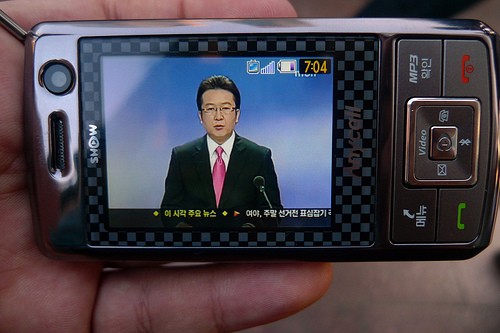Before I get to updating more pictures and more minutia on traveling out of a backpack, I thought it would be good to cover the media/TV saturation in Korea. Getting away from audio-video stimuli in Korea is near-impossible. With a few number of corporately-manufactured artists (like Girl’s Generation) penetrating the musical consciousness, anyone in Korea longer than a month will learn a crappy pop song by a sort of osmosis.
While I think the corporate pop scene in Korea is a bit insidious, the media that scares me in a different way is the proliferation of DMB, or Digital Multimedia Broadcasting. This technology allows a relatively high-quality television signal to be received on cell phones, subway trains, GPS devices and car dashboards at no cost to the consumer. Some five years after the technology’s launch, South Korea has 15 TV channels and 19 radio channels and 3 data channels, according to Wikipedia.
Because Korea is about the size of the Indiana with about 48 million people, some technologies have managed to flourish that would would otherwise be prohibitively expensive in the United States. For example, Korea has the highest average Internet speed in the world (14.58 mbps to America’s 3.88mbps) because its much smaller area. With that in mind, this tightly-packed, densely urban nation was ripe for the invention and development of DMB. For me, this technology is the complete embodiment of Korea’s technology and media saturation.
On any given bus ride during commuting hours dozens of people will be glued to tiny screens watching baseball, soap operas, the news, comedy shows and even traffic reports. No books, magazines or newspapers, just the glow from their tiny screen. Heading into Seoul, however, especially near the universities, you will slowly see more reading. It can be a bit surprising at first.
When the iPod first released the video feature in 2005, critics were up in arms with the implication that Americans must be entertained at every moment of the day. Now, you can get streaming video from Justin.TV directly onto your iPhone. But I think this is still a bit different as the Apple brand is the only one to pioneer mobile media. DMB works across all platforms.
Not everyone has the tiny screens for their DMB. Most cabbies and commuters have GPS devices or dashboards screens that are easily 7″ to 12″ with the technology. People usually have their favorite soap operas running when they are stuck at (absurdly long) traffic lights through the day. The scary part is that it is completely legal to watch TV while driving in Korea.
In November, the BBC reported that Cabbies in Korea won a legal fight for the right to watch TV while in their car after a new city law in Seoul attempted to bar it. The same BBC piece also revealed that there are about 351 injuries as a result of people watching their DMB TVs. It doesn’t specify if the 351 were in Seoul or around Korea. My bet is Seoul.
Most people don’t seem to have a problem with it. They think it’s not a distraction. I don’t see how that’s possible when the entirety of Korea’s advertising strategy is based on distractions. Flashing neon, inflatable signs, dancing models advertising washing machines on the street and gaudy plaster statues are exactly what is done to get your attention at all costs.
My guess is that most Koreans are no longer distracted by the distractions. Maybe it just makes me sound like a bumpkin who would rather pine for spending solitary afternoon in the Sierra Nevadas staring at a small lake without no other person for miles.





testing